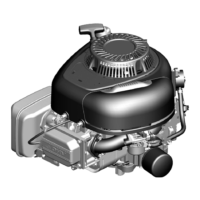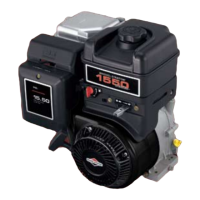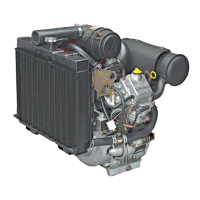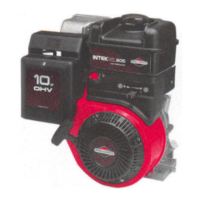10
BRIGGSandSTRATTON.COM
1. Remove the fastener (A) and the c over (B).
2. Remove the fastener (C) and the filter (D).
3. Remove the pre-cleaner (E), if equipped, from the filter. To loosen debris, gently tap
the filter on a hard surface. If the filter is excessively dirty, replace with a new filter.
4. Wash the pre-cleaner in liquid detergent and water. Then allow it to thoroughly air
dry. Do not oil the pre-cleaner.
5. Assemble the dry pre-cleaner to the filter.
6. Install the seal washer (F), the filter, and the pre-cleaner, if equipped, into the base
(G) and onto stud (H). Make sure filter is properly assembled into base and secure
with the fastener.
7. Install the cover and secure with the fastener (A). Make sure the fastener is tight.
Foam Filter - Figure
14
1. Loosen the fastener (A) that holds the cover (B).
2. Open the cover and remove the filter (C).
3. Wash the foam element in liquid detergent and water. Squeeze dry the foam element
in a clean cloth.
4. Saturate the foam element with clean engine oil. To remove the excess engine oil,
squeeze the foam element in a clean cloth.
5. Install the filter (C).
6. Install the air filter cover and secure with the fastener.
How To Clean The Air Cooling System - Figure
15
Running engines produce heat. Engine parts, especially muffler,
become extremely hot.
Severe thermal burns can occur on contact.
Combustible debris, such as leaves, grass, brush, etc. can catch fire.
WARNING
Allow muffler, engine cylinder and fins to cool before touching.
Remove accumulated debris from muffler area and cylinder area.
NOTICE: Do not use water to clean the engine. Water could contaminate the fuel
system. Use a brush or dry cloth to clean the engine.
This is an air cooled engine. Dirt or debris can restrict air flow and cause the engine to
overheat, resulting in poor performance and reduced engine life.
Use a brush or dry cloth to remove debris from the finger guard (A) (Figure 15). Keep
linkage, springs and controls (B) clean. Keep the area around and behind the muffler (C)
free of any combustible debris.
Storage
WARNING
Fuel and its vapors are extremely flammable and explosive.
Fire or explosion can cause severe burns or death.
When Storing Fuel Or Equipment With Fuel In Tank
Store away from furnaces, stoves, water heaters or other appliances that have
pilot light or other ignition source because they can ignite fuel vapors.
Fuel System
Fuel can become stale when stored over 30 days. Stale fuel causes acid and gum
deposits to form in the fuel system or on essential carburetor parts. To keep fuel fresh,
use Briggs & Stratton Advanced Formula Fuel Treatment & Stabilizer, available
wherever Briggs & Stratton genuine service parts are sold.
There is no need to drain gasoline from the engine if a fuel stabilizer is added according
to instructions. Run the engine for 2 minutes to circulate the stabilizer throughout the fuel
system before storage.
If gasoline in the engine has not been treated with a fuel stabilizer, it must be drained into
an approved container. Run the engine until it stops from lack of fuel. The use of a fuel
stabilizer in the storage container is recommended to maintain freshness.
Engine Oil
While the engine is still warm, change the engine oil.
Troubleshooting
Need Assistance? Go to BRIGGSandSTRATTON.COM or call 1-800-233-3723 (in
USA).
Specifications
Engine Specifications
Model 190000
Displacement 18.67 ci (306 cc)
Bore 3.228 in (82 mm)
Stroke 2.283 in (58 mm)
Engine Oil Capacity 35 -- 39 oz (1.05 -- 1.15 L)
Engine Specifications
Model 250000
Displacement 25.63 ci (420 cc)
Bore 3.543 in (90 mm)
Stroke 2.598 in (66 mm)
Engine Oil Capacity 35 -- 39 oz (1.05 -- 1.15 L)
Tune-up Specifications *
Model 190000, 250000
Spark Plug Gap 0.030 in (0.76 mm)
Spark Plug Torque 275 lb-in (31 Nm)
Armature Air Gap 0.008 - 0.016 in (0.2 - 0.4 mm)
Intake Valve Clearance 0.005 - 0.007 in (0.13 - 0.18 mm)
Exhaust Valve Clearance 0.005 - 0.007 in (0.13 - 0.18 mm)
* Engine power will decrease 3.5% for each 1,000 feet (300 meters) above sea level and
1% for each 10 F(5.6 C) above 77 F(25 C). The engine will operate satisfactorily at
an angle up to 15. Refer to the equipment operator ’s manual for safe allowable
operating limits on slopes.
Common Service Parts n
Service Part Part Number
Foam Air Filter, Round (Model 250000) 799819
Foam Air Filter, Flat 591778
Flat Air Filter 491588, 5043
High Capacity Air Filter 799818
Advanced Formula Fuel Treatment &
Stabilizer
100117, 100120
Spark Plug (Resistor) 797235
Spark Plug (Non-Resistor) 798615
Spark Plug Wrench 19605
Spark Tester 19368
n We recommend that you see any Briggs & Stratton Authorized Dealer for all
maintenance and service of the engine and engine parts.
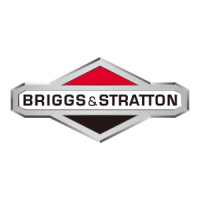
